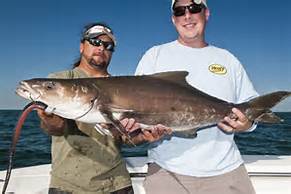
Dr. Ken Neill, III
Cobia is closed for 2017. Well, the fishery is closed in federal waters and with a new administration settling in D.C., and we will see if it stays closed. But for now, it is closed for the year. Based on estimated catches greatly exceeding the allowable catch the previous two years, and the assumption that states will keep cobia open in state waters, federal waters are closed. The estimated recreational catch is made by an extrapolation of a very few observed dockside fish and the allowable catch is based on an old stock assessment along with a management line drawn at the Florida-Georgia border. The east coast of Florida is given a higher “allowable cobia catch” than the rest of the US east coast combined. It should be apparent to anglers that we need better science, a current stock assessment and much better catch data.
We will find out what North Carolina is going to do with that state’s cobia regulations over the next couple of months. Anglers need to be active and involved in these decisions. I expect both states to have cobia fisheries this year, but do not know how restrictive they will be. I do anticipate vigorous enforcement of the new mandatory cobia permits and reporting.
There are numerous cobia studies being done at the Institute of Marine Science that anglers can help with. The PSWSFA is joining this effort. There will not be a Flounder Bowl this year. Due to the cobia situation, we will host a new tournament, the “Cobia Bowl”, to raise funds for cobia research at VIMS. This tournament will also be used to collect catch data and cobia samples for VIMS scientists. The tournament will be held June 22-24 dependent on regulations.
In other management news, anglers face a large reduction in the flounder quota. In sort of good news, flounder catches have been so poor, this reduction may mean little to our anglers. We may have no regulation changes at all or we could have an inch increase in minimum length and/or a 1-fish reduction in bag limit. Sea bass is rather interesting. We faced a quota reduction in addition to the annual 200-300% recreational estimated catch of the allowed total each of the past several years, but a new stock assessment has been done. This assessment found that in spite of anglers supposedly catching way too many sea bass each year, the population is in fantastic shape. This will result in a large increase in the allowed catch, but will not cover all of the estimated annual recreational excess catch. The result will be an additional tightening of recreational sea bass regulations but only by a little bit (even though the population is booming under current regulations).
Bills have been introduced to restore funding to the Saltwater Tournament. There is a good chance that this program will be restored, but anglers need to continue to contact their representatives in Richmond.
Virginia Saltwater
By Dr. Julie Ball
February is here, and according to Punxsutawney Phil, we have six more long weeks of winter. With limited choices on the saltwater front, many are hopeful that the spring will hold better options.
Unfortunately, the striped bass fishery is not happening this winter, with schools of big rockfish lingering well out of reach of boats offshore. It seems the only hope now is to intercept the schools of rockfish as they head into the Bay to spawn in early spring. In the Bay, catch and release is a possibility.
Although the tautog bite in Bay waters is slowing, some decent fish are hitting for anglers on some Bay and inshore structures. Deeper wrecks are producing the larger fish, but reaching them can be a challenge this time of year. When boats can get out, anglers are finding nice fish. Sea bass will also take your offerings on many of these structures, but they are still out of season.
Nags Head
Jennette’s Pier anglers have been catching shad this week, meaning they are heading north to the Virginia bay and tidal rivers, and that’s good news.
More good news from Oregon Inlet.
The Bluefin have arrived offshore. One private boat caught a 70 incher and another boat reportedly caught several more of the big Bluefin.
In the surf, the winds were NW at 18 on Thursday and the water was still a chilly 47 degrees.
Hatteras
Red Drum reported that fishing has been slow overall, but it was a pretty day on Wednesday after the rain stopped. Between Ramp 43 and 44 there were some small Black Drum, Blow Toads and small Flounder beached. Fishing has been a little slow but a pretty day after the rain stopped. Between Ramp 43 and 44 there were some small Black Drum, Blow Toads and small Flounder. There were some big sharks landed and hooked up off The Point.
Offshore, one boat commercial fished on Monday, catching King Mackerel, Albacore and a Swordfish.

